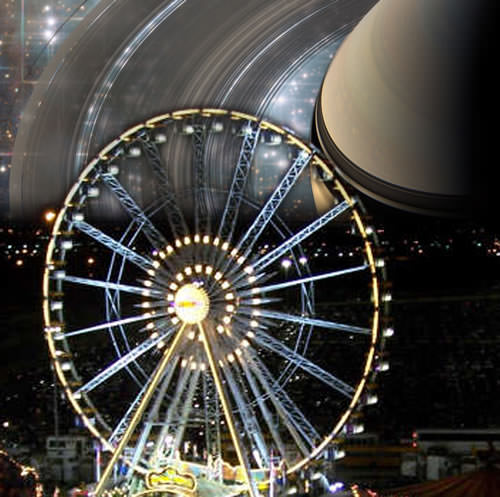Host: Fraser Cain
Guests: Matthew Francis, Nicole Gugliucci, Brian Koberlein, Morgan Rehnberg, Mike Simmons
Continue reading “Weekly Space Hangout – March 21, 2014: Cosmos & Gravitational Waves!”
Bill Nye on Taking Astronomy with Carl Sagan
“This is how we know nature. It is the best idea humans have ever come up with.”
– Bill Nye, Science Guy and CEO of The Planetary Society
In this latest video from NOVA’s Secret Life of Scientists and Engineers, science guy Bill Nye talks about the incredible influence that Carl Sagan had on his life, from attending his lectures on astronomy at Cornell University to eventually becoming CEO of The Planetary Society, which was co-founded by Sagan in 1980.
“I took astronomy from Carl Sagan.” Now there’s a statement that’ll get people’s attention. (It got mine, anyway.)
Space Geek Heaven: Man’s ‘Museum’ Contains Thousands Of Collectables
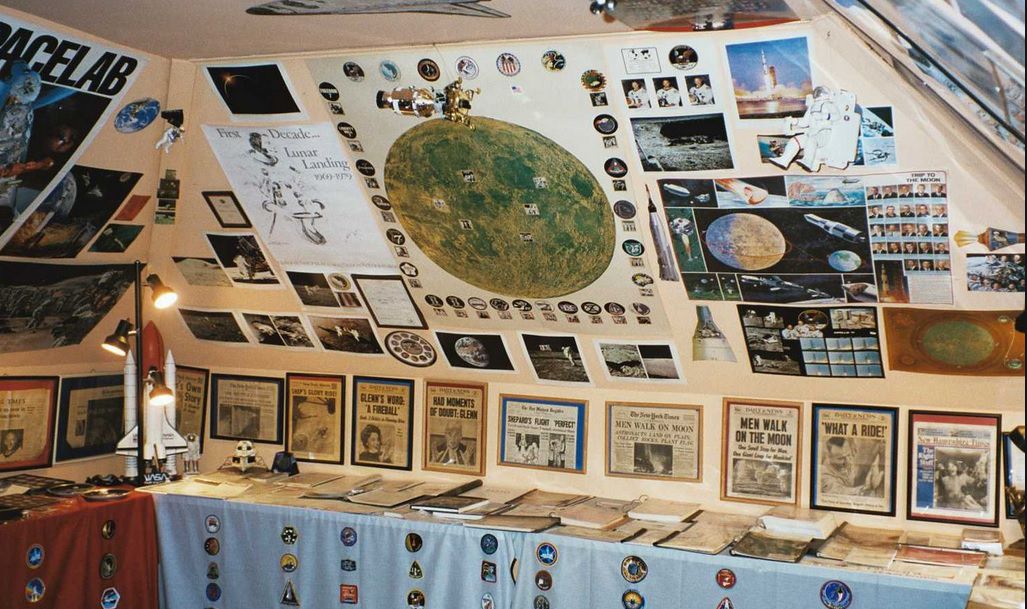
We’re all space geeks at Universe Today and are used to seeing collections of memorabilia, but there’s something about Joe Lennox’s that makes us set our phasers to stunned. Ever since John Glenn first rocketed to space 52 years ago, Lennox has been amassing a collection of newspaper articles, astronaut autographs, books and other memorabilia that he has on display in his New York City-area home.
As a child, he had to fight to save stuff with his sister; they eventually agreed to a “joint venture”, Lennox said. For 10 years, they clipped newspapers, wrote to NASA astronauts and space program employees (collecting their responses), and started branching out to movies and other things covering space exploration. Their mother allowed them to display the items in a back bedroom. Eventually, the interest of Lennox’s sister faded, but his only deepened.
The collection has been through a few moves; his parents moved in 1978, meaning the stuff had to be stored wherever Lennox could find storage space until he and his wife bought their own house in 1990. There’s a spare bedroom available to display the collection, but the pictures indicate it’s simply bursting with items.
“My only problem is I don’t have enough room, because obviously as the years go by, I write (more) letters and purchase things,” Lennox told Universe Today.
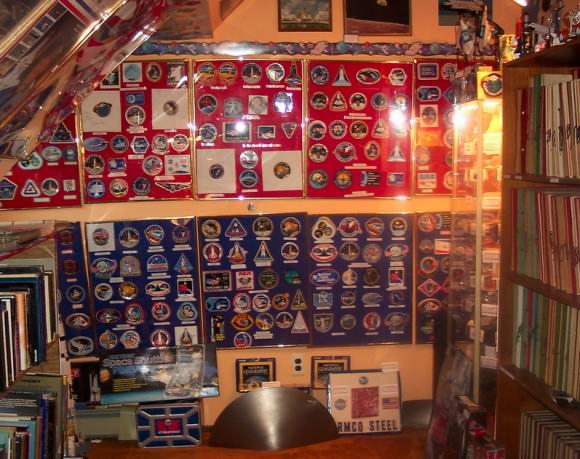
Lennox makes sure to display his collection as carefully as he can. Scrapbook pages are acid-free, and letters are stored in acid-free folders as well. He says he has received space hardware (sometimes flown hardware) from contractors and others over the years, which he keeps in sealed display cases. Anything that remains outside of a sealed environment gets covered with a cloth when he’s not showing off the collection to house visitors.
It would be very difficult for a space fan to build such a collection today, he adds. NASA’s rules about “flown items” and other space memorabilia are tougher, with most items going to places such as the Smithsonian. Fewer people seem to answer his letters, too, Lennox said. “In the old days, if I wrote 100 letters, I would venture to say we got 95 really, really good responses. Today, if I wrote 100 letters I might get five responses. It’s very depressing, I got to tell you.”
With Lennox’s interest, a natural next question would be to ask if he ever considered working for NASA itself. While he never got that chance, the story ends up being a good one for the schoolkids he regularly speaks with.
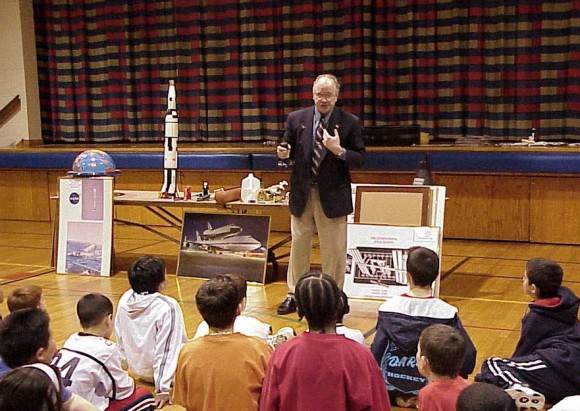
Lennox said he never wanted to be an astronaut — “I’m not smart enough and don’t have the courage” — but he did have aspirations to be a flight controller. He said he began his university engineering studies with the idea for working for NASA, and happily worked away at his degree for a year and a half. Then he discovered he was going blind, requiring two corneal transplants.
The transplants worked, but it delayed his studies by four years and his eyesight was not as good as it used to be, meaning Lennox felt it was best to switch careers. He ended up in the banking industry, still writing letters to NASA and others the entire time. Now retired, he’s switching his energies over to teaching kids about space.
“I give presentations throughout New Jersey, 45 or 50 a year, where I go and I teach people about the space program,” he said. “I teach kids, I teach adults, I have probably 30 or 40 different presentations.”
His big message: “I want the children to understand they should never give up on their goals. If they have a goal in their life and it seems it can’t be reached because of health, like me, or money or relocation or whatever, they still can do it.”
You can see more pictures of Lennox’s “museum” below or at his website. He said he has willed the collection to an Orlando-area museum upon his death, meaning it could be viewable by the public in generations to come.
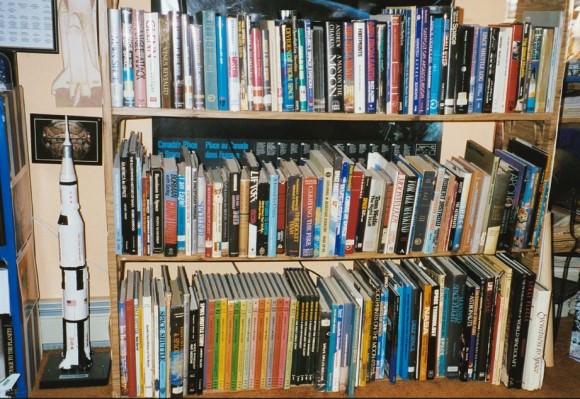
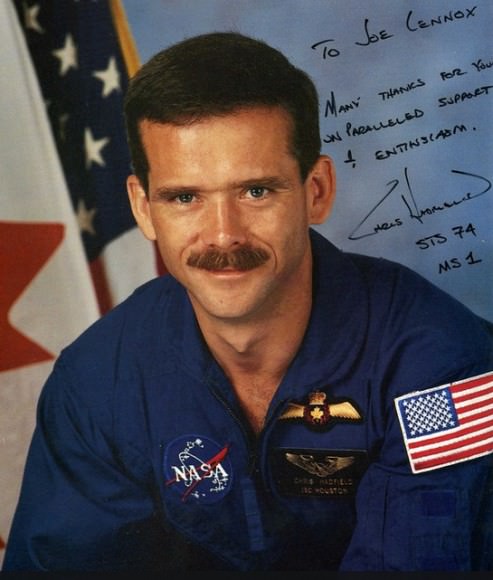
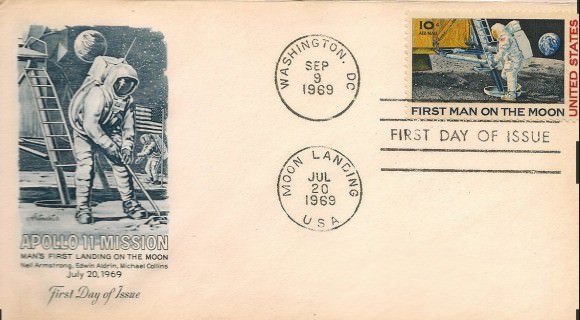
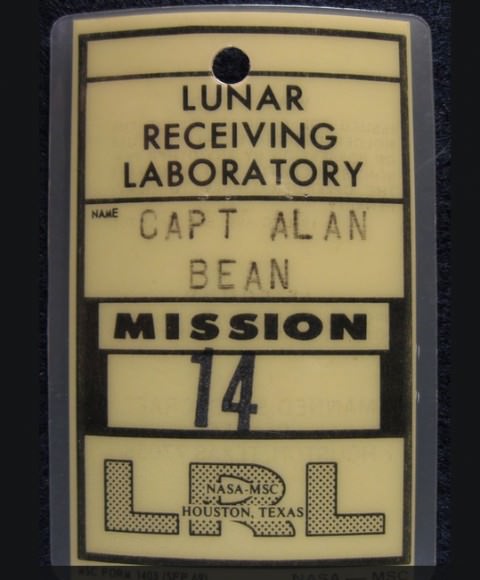
360 Degrees of Milky Way at Your Fingertips
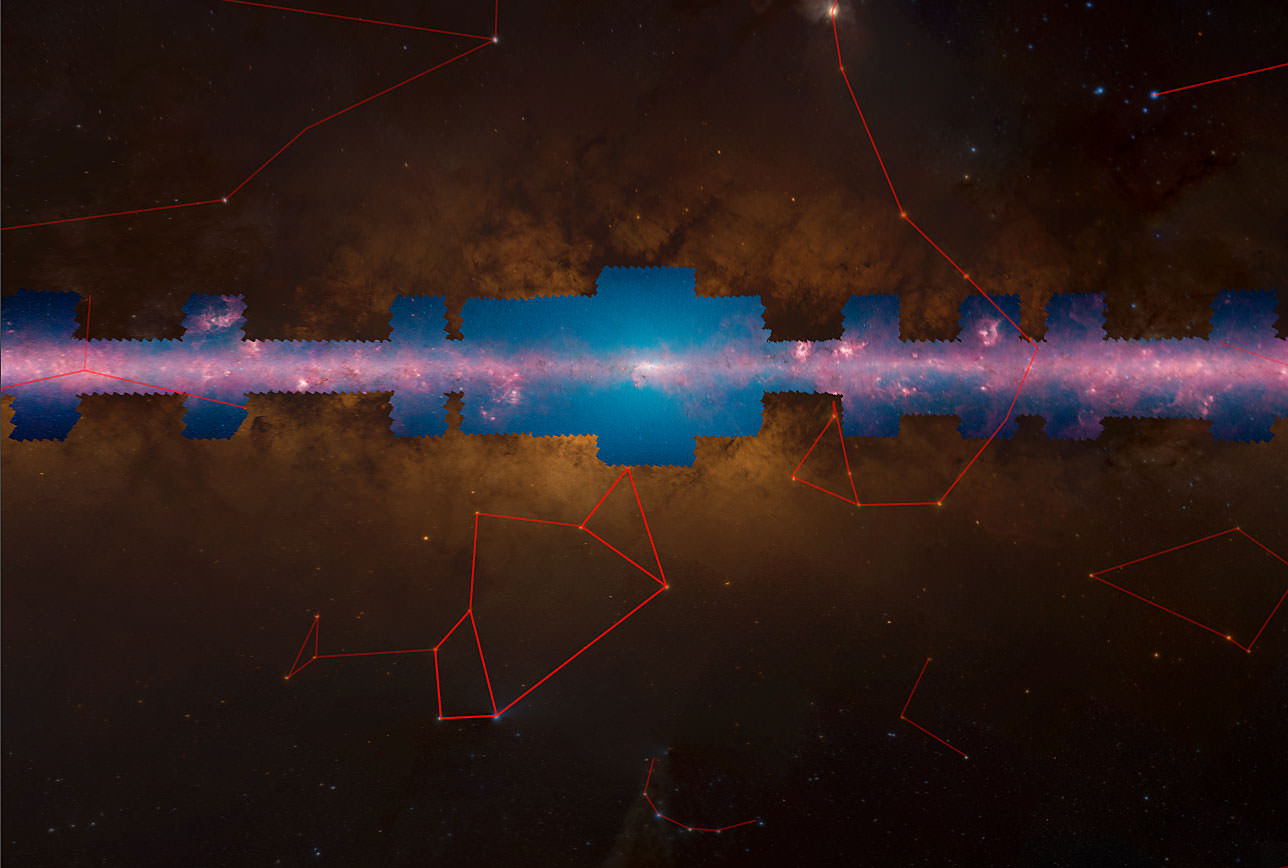
Touring the Milky Way’s a blast with this brand new 360-degree interactive panorama. More than 2 million infrared photos taken by NASA’s Spitzer Space Telescope were jigsawed into a 20-gigapixel click-and-zoom mosaic that takes the viewer from tangled nebulae to stellar jets to blast bubbles around supergiant stars.

The new composite, using infrared images taken over the past decade, was compiled by a team led by UW-Madison astronomer Barbara Whitney and unveiled at a TEDactive conference in Vancouver, Canada Thursday. Unlike visual light, infrared penetrates the ubiquitous dust concentrated in the galactic plane to reveal structures otherwise obscured.
Catching a GLIMPSE of the Milky Way in this short video presentation
“For the first time, we can actually measure the large-scale structure of the galaxy using stars rather than gas,” explained Edward Churchwell, UW-Madison professor of astronomy and team co-leader. “We’ve established beyond the shadow of a doubt that our galaxy has a large bar structure that extends halfway out to the sun’s orbit. We know more about where the Milky Way’s spiral arms are.”
Named GLIMPSE360 (Galactic Legacy Mid-Plane Survey Extraordinaire project), the deep infrared survey captures only about 3% of the sky, but because it focuses on the plane of the Milky Way, where stars are most highly concentrated, it shows more than half of all the galaxy’s 300 billion suns.

Using your imagination to hover high above the galactic plane, you’d see the Milky Way is a flat spiral galaxy sporting a stubby bar of stars crossing its central bulge. The solar system occupies a tiny niche in a minor spiral arm called the Orion Spur two-thirds of the way from the center to the edge. At 100,000 light years across, the Milky Way is vast beyond comprehension and yet it’s only one of an estimated 100 billion galaxies in the observable universe.
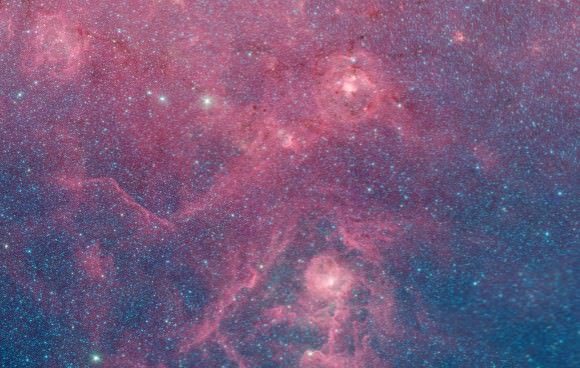
While you and I sit back and marvel at all the stellar and nebular eye candy, the Spitzer images are helping astronomers determine where the edge of the galaxy lies and location of the spiral arms. GLIMPSE images have already revealed the Milky Way to be larger than previously thought and shot through with bubbles of expanding gas and dust blown by giant stars.
Spitzer can see faint stars in the “backcountry” of our galaxy — the outer, darker regions that went largely unexplored before.
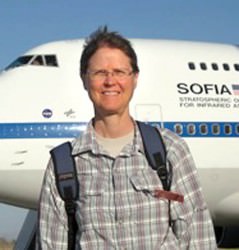
“There are a whole lot more lower-mass stars seen now with Spitzer on a large scale, allowing for a grand study,” said Whitney. “Spitzer is sensitive enough to pick these up and light up the entire ‘countryside’ with star formation.”
The new 360-degree view will also help NASA’s upcoming James Webb Space Telescope target the most interesting sites of star-formation, where it will make even more detailed infrared observations.
When you play around with the interactive mosaic, you’ll notice a few artifacts here and there among the images. Minor stuff. What took some getting used to was how strikingly different familiar nebulae appeared when viewed in infrared instead of visual light. The panorama is also available on the Aladin viewing platform which offers shortcuts to regions of interest.
Neil deGrasse Tyson, astrophysicist and host of the new Cosmos TV series, gave the third line of our “cosmic address” as the Milky Way after ‘Earth’ and ‘Solar System’. After a few minutes with GLIMPSE360 you’ll better appreciate the depth and breadth of our galactic home.
A Terrifying Virtual View Of Floating Away From The Space Station
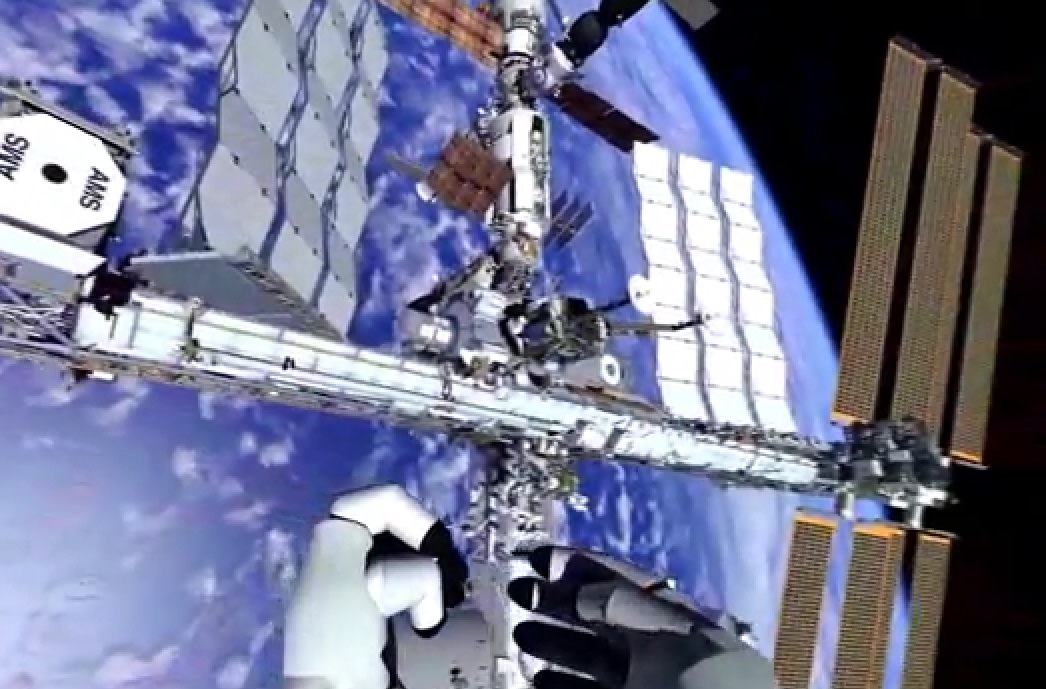
You wanna talk about fear? This view would likely be many people’s worst nightmare — being in a spacesuit, untethered, floating away from the International Space Station and its relative safety. NASA has astronauts covered for this Gravity-type scenario, however, with a sort of jet backpack that can send astronauts back to safety.
A new video featuring European Space Agency astronaut Alexander Gerst (also embedded below) explains the steps an astronaut would take to swing back to safety. “We actually train how to use that in the virtual reality lab,” he said shortly after the video showed an astronaut floating away.
The key lies in a system called SAFER (Simplified Aid for EVA Rescue), which Gerst has practiced on numerous times (virtually) in preparation for his flight in May, which could involve spacewalks if NASA addresses a spacesuit water leak problem in time.
“You have to train it for a while to operate and actually come back, and not miss the station and fly into the blackness of space,” Gerst said.

The Russian Orlan spacesuit (which Gerst is also trained on) does not have such a system, but Roscosmos gets around that by having a different procedure for spacewalking than the Americans. The Russians mandate a minimum of two attachment points to station at all times, whether it’s a pair of tethers or a tether and a gripped hand.
Gerst emphasizes a floating away scenario is unlikely, in either case — it would involve losing the anchor, losing the tether and also losing your grip all at the same time. While this has never actually happened, NASA did test the SAFER system in space on STS-64 in 1994 with a crew member standing by on the Canadarm robotic arm if something went wrong. In 2000, two astronauts aboard STS-92 each did a 50-foot flight with the system.
In 2006, the SAFER system got a little loose on the back of astronaut Piers Sellers, necessitating a tether fix. NASA emphasized that the system was not in danger of being lost.
You can view the section on SAFER in the video below at around 6 minutes. Gerst recorded this as a summary of his training ahead of Expedition 40/41, which lifts off in May.
ff
NASA Unveils Orion’s Powerful Delta IV Heavy Rocket Boosters for Dec. 2014 Blastoff
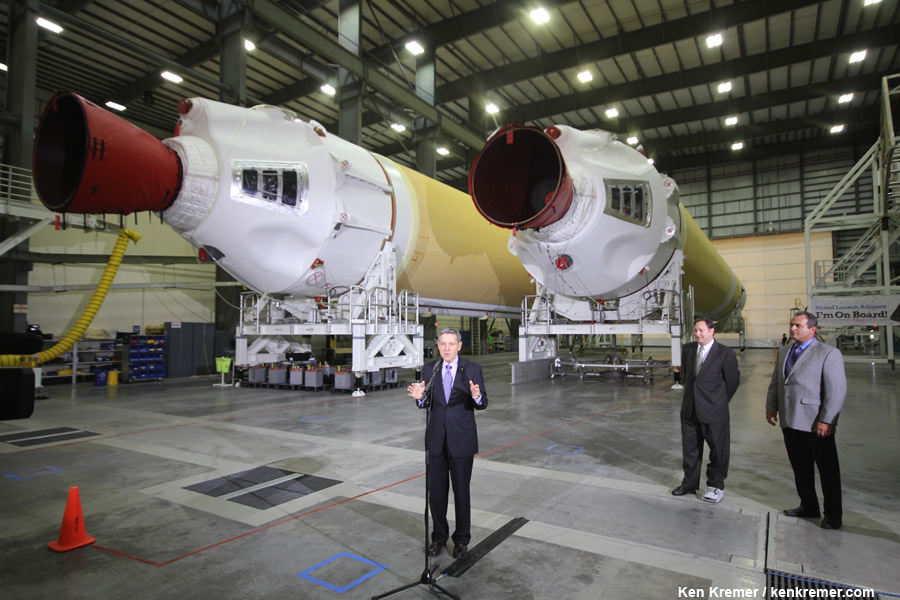
CAPE CANAVERAL AIR FORCE STATION, FL – Production and assembly of virtually all of the key hardware elements for NASA’s eagerly anticipated Orion EFT-1 uncrewed test flight are either complete or nearing completion at the Kennedy Space Center and Cape Canaveral.
Two of the three first stage boosters comprising the mammoth Delta IV Heavy rocket that will propel Orion to high Earth orbit have arrived at Cape Canaveral Air Force Station, Florida, and were unveiled this week by top NASA managers at a media briefing attended by Universe Today.
The triple barreled Delta IV Heavy rocket is currently the most powerful rocket in America’s fleet and the only one capable of launching the Orion EFT-1 capsule to its intended orbit of 3600 miles altitude above Earth.
Due to urgent US national security requirements, the maiden blastoff of the unmanned Orion pathfinder capsule – that will one day send humans back to the Moon and beyond Earth’s realm – has just been postponed about three months from September to December 2014 in order to make way for the accelerated launch of recently declassified US Air Force Space Surveillance satellites – as I reported here.
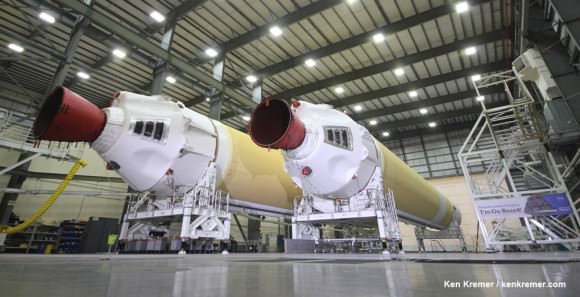
The center and starboard side boosters recently arrived at the Cape aboard a barge from Decatur, Alabama where they were manufactured by United Launch Alliance (ULA).
The remaining port side booster and the Centaur upper stage are due to be shipped by ULA to Cape Canaveral in April.
“It’s great to see Orion, the next step in our journey of exploration, said NASA Associate Administrator Robert Lightfoot. “And it’s very exciting to see the engines integrated into the booster.”
“This mission is a stepping stone on NASA’s journey to Mars. The EFT-1 mission is so important to NASA. We will test the capsule with a reentry velocity of about 85% of what expect on returning [astronauts] from Mars.”
“We will test the heat shield, the separation of the fairing and exercise over 50% of the eventual software and electronic systems inside the Orion spacecraft. We will also test the recovery systems coming back into the Pacific Ocean.”
Despite the EFT-1 launch postponement, Kennedy Space Center Director Bob Cabana said technicians for prime contractor Lockheed Martin are pressing forward and continue to work around the clock at the Kennedy Space Center (KSC) in order to still be ready in time to launch by the original launch window that opens in mid- September 2014.
“The contractor teams are working to get the Orion spacecraft done on time for the December 2017 launch,” said former shuttle commander Cabana.
“They are working seven days a week in the Operations and Checkout High Bay facility to get the vehicle ready to roll out for the EFT-1 mission and be mounted on top of the Delta IV Heavy.”
“I can assure you the Orion will be ready to go on time, as soon as we get our opportunity to launch that vehicle on its first flight test and that is pretty darn amazing.”
“It’s great to see all the hardware and boosters that will take Orion to orbit.”
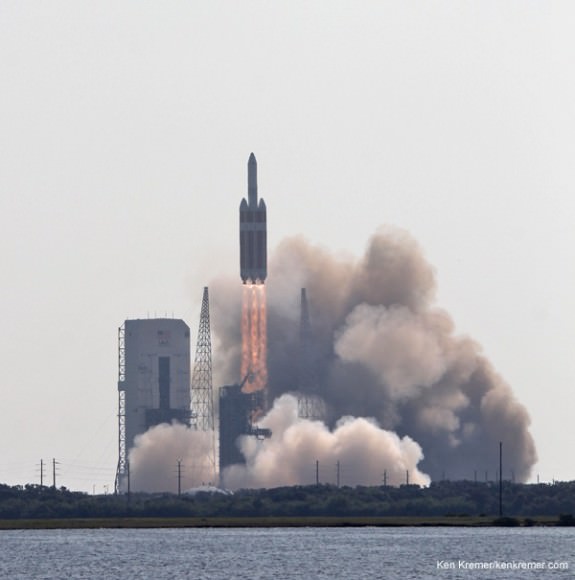
Universe Today also confirmed with Cabana that NASA will absolutely not delay any Orion processing and assembly activities.
“Our plan is to have the Orion spacecraft ready because we want to get EFT-1 out so we can start getting the hardware in for Exploration Mission-1 (EM-1) and start processing for that vehicle that will launch on the Space Launch System (SLS) rocket in 2017,” Cabana told me standing besides the Delta IV boosters inside the ULA Horizontal Integration Facility at Cape Canaveral.
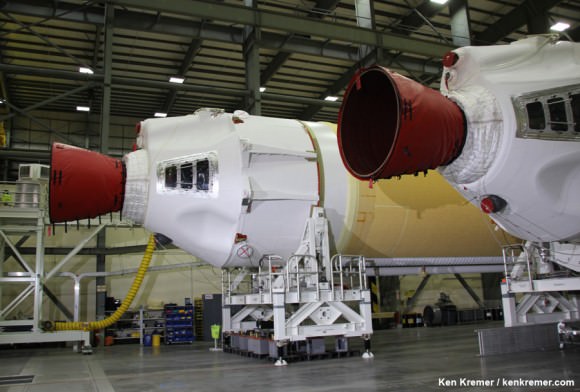
The two-orbit, four- hour EFT-1 flight will lift the Orion spacecraft and its attached second stage to an orbital altitude of 3,600 miles, about 15 times higher than the International Space Station (ISS) – and farther than any human spacecraft has journeyed in 40 years.
Although the mission will only last a few hours it will be high enough to send the vehicle plunging back into the atmosphere and a Pacific Ocean splashdown to test the craft and its heat shield at deep-space reentry speeds of 20,000 mph and endure temperatures of 4,000 degrees Fahrenheit – like those of the Apollo moon landing missions.
The EFT-1 mission will provide engineers with critical data about Orion’s heat shield, flight systems and capabilities to validate designs of the spacecraft, inform design decisions, validate existing computer models and guide new approaches to space systems development. All these measurements will aid in reducing the risks and costs of subsequent Orion flights before it begins carrying humans to new destinations in the solar system.
“Orion EFT-1 is really exciting as the first step on the path of humans to Mars,” said Lightfoot. It’s a stepping stone to get to Mars.”
Stay tuned here for Ken’s continuing Orion, Chang’e-3, Orbital Sciences, SpaceX, commercial space, LADEE, Mars rover, MAVEN, MOM and more planetary and human spaceflight news.
Learn more at Ken’s upcoming presentations at the NEAF astro/space convention, NY on April 12/13 and at Washington Crossing State Park, NJ on April 6. Also evenings at the Quality Inn Kennedy Space Center, Titusville, FL, March 24/25 and March 29/30
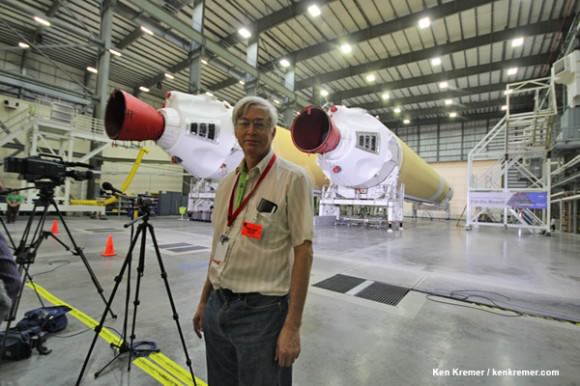
Book Review: “Our Mathematical Universe – My Quest for the Ultimate Nature of Reality”
Mathematics seems to be the bane of many people, and especially many authors. Editors will often say that putting any mathematical equation into a book will sideline it to a destiny of either a textbook or dust collector. So what is an author to do? It appears Max Tegmark plays this line by continually talking about mathematics but never actually using any in his book ‘Our Mathematical Universe – My Quest for the Ultimate Nature of Reality.’ From a publisher’s view, this is a keen gambit. From a reader’s point of view, there may be referrals to some fancy equations but the lack of mathematics serves to convey this author’s message very well.
Max Tegmark is a professor of physics at MIT and a leading expert on theories of the Universe. But he writes with aplomb about a subject of which few people have much grasp and fewer people can manipulate. In a nutshell, he runs through the tenants of extreme physics both in the time and size dimensions, that is, from quarks to galaxies and from the big bang to whatever string theory may have in store for us.
The tentative hypotheses defining our future drive most of the original work in this book. Specifically starting from the Uncertainty Principle, the author argues that all possibilities can and indeed will occur. Just try following along with his argument about a quantum machine gun to determine life and/or death (but don’t try this at home). He then goes on to argue that an infinite number of universes are needed to enable all these options. Next, and apparently his personal purpose of the book, is his appreciation that given these probability states and the finite representation for basic physical entities in our universe, such as the dark-energy density, then our universe and indeed any universe is equivalent to a mathematical structure. This prognosis is his rationale for entitling his book Our Mathematical Universe. He then goes on to claim that this underlying mathematical structure should be the much sought after Theory of Everything. However, he readily admits in his book that he hasn’t got all the details just yet.
While Tegmark has presumably written this book for the lay person, there is a strong sense of an academic grounding in the writing style. The subject is solidly technical with only the occasional interpose of the author’s personal life. There’s a bit about his family, though not much more than that he has one. There’s much more about the physicists that have touched upon his career as well as conferences he’s attended and papers that he’s written. But still, the feeling of being near textbook like does appear. Perhaps this is what makes this book a bit more of a challenge to read. It’s not the difficult prose but the author’s many thought experiments usually based upon mathematical arguments. Reading it requires hard thinking that puts into question your very existence and indeed whatever you may think the purpose may be of your existence. But the reading can be very rewarding even for the lay purpose who’s looking for the latest in cosmology and physics.
So, this book is what we get apparently when a professor has become tenured. It’s a solid personal view that has more to do with what they feel is correct than what is the social or academic norm. Tegmark admits to and writes of some very off norm points in his life. His book ‘Our Mathematical Universe – My Quest for the Ultimate nature of Reality’ may be his most off putting. But equally, he shows the true value of universities, where the best and brightest can advance the knowledge of our species for all to share and from which all profit.
Carnival of Space #345
This week’s Carnival of Space is hosted by our pal Ray Sanders at his Dear Astronomer blog.
Click here to read Carnival of Space #345.
And if you’re interested in looking back, here’s an archive to all the past Carnivals of Space.
If you’ve got a space-related blog, you should really join the carnival. Just email an entry to [email protected], and the next host will link to it. It will help get awareness out there about your writing, help you meet others in the space community – and community is what blogging is all about. And if you really want to help out, sign up to be a host. Send an email to the above address.
NASA ‘Game-Changing’ Space Propellant Tank To Stay Grounded For Now

A lighter and stronger “game-changing” tank that could have flown in space in a few years will be tested on the ground only, at least for now, according to the NASA budget and a few reports.
Last year, the agency conducted ground tests on a composite propellant tank intended to be better than its heavier counterparts, saving on launch costs. At the time, NASA said it was aiming to test this on a demonstration flight in 2018, but the new budget request says testing will stay grounded.
“Cryogenic Propellant Storage and Transfer will reformulate from a flight demonstration mission into a series of large-scale ground demonstrations supportive of future exploration propulsion needs and upgraded versions of SLS,” the agency stated, which could leave the door open for future tests in space.
The information is mentioned on Page 336 of the 713-page budget request document NASA released earlier this month. The budget is not finalized and is subject to approval from Congress. More high-profile cuts include the SOFIA airborne telescope and the Opportunity Mars rover mission.
The cryogenic change was mentioned in a few news reports, and then highlighted in a press release today (Thursday) from an advocacy group called the Space Development Steering Committee, who says these tanks would have been good for space-based refueling stations.
“Instead of trying out technologies designed for space where they count — in space — space gas station technologies are now going to be tested down here on Earth, where we already know how to make them function,” SDSC’s press release read. “Down here where we do not face the challenges of weightlessness and vacuum. Down here where it’s useless.”
The SDSC includes the heads of the National Space Society, the Space Frontier Foundation, and the Mars Society, plus past astronauts and former NASA employees (among others). In November, the committee released an unfunded gas-tanks-in-space proposal to fuel missions to Mars.
What Happens When The Poles Flip?
Have you heard the terrifying news that the Earth’s poles are going to flip? What does “flipping” mean? And if the Earth’s poles do flip, are we in any danger?
Have you heard the startling news that the Earth’s poles might flip? Perhaps in the response to a close pass from the mysterious Planet X? Are you imagining the entire Earth actually flipping over on its side or rotating upside down, possibly while Yakkity Sax plays in the background? When will this happen? Can this happen?
First, there’s no secret planet hurtling through the Solar System causing chaos and orbital disturbances. So could the Earth spontaneously physically flip over? Some planets have already been tilted and flipped.
Take a look at Uranus. Its orbital tilt is 98-degrees. We assume the planet started with the same tilt as the rest of the Solar System, and some event in the ancient past caused it to fall over. It could have collided with another planet, billions of years ago, or gravitational interactions with other giant planets pushed it over.
And then there’s Venus, its axial tilt is 177-degrees. That’s essentially upside down. Venus is turning in the opposite direction from every other planet in the Solar System. Standing on the surface of Venus, you would see the Sun rise in the West and set in the East. Astronomers don’t know why this happened, perhaps it was gravitational interactions or a collision with another planet.
To actually flip a planet off its axis would take an event so catastrophic that it would devastate the planet. Don’t worry, as far as we know, those kinds of events and interactions stopped happening billions of years ago.
That’s the good news. The Earth isn’t likely to just fall over, or get bashed on its side like an office tower under the might of Godzilla
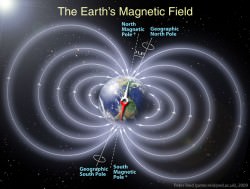
Now what about those magnetic poles. On Earth, they can and do reverse on a regular basis. The Earth is often shown like a giant bar magnet, with a north magnetic pole and a south magnetic pole. Over vast periods of time, the Earth’s north pole becomes its south pole, and vice versa. Geologists measure the magnetic configuration of iron particles in ancient lava flows. in one part of the lava flow, the particles oriented with one magnetic configuration, and then in another, the particles were reversed. It turns out the planet reverses its polarity every 450,000 years, and the last reversal happened about 780,000 years ago. Which means it could happen in the next few thousand years.
If the Earth’s poles did reverse, what would happen to us? If the magnetic field disappeared entirely, the planet would be bathed in radiation from the Sun, which would likely cause an increase in cancer. But the Earth’s atmosphere would still protect us from majority of radiation.
What about mass extinctions? Scientists have wondered if there’s a link between them and magnetic reversals.
Fortunately for us, there doesn’t seem to be any connection. Whenever geomagnetic reversals happened in the past, it didn’t devastate life on Earth. So don’t worry about it.
There is a pretty good chance it won’t happen in our lifetime, and maybe not for hundreds of thousands of years. And even if the Earth’s poles flip, it wouldn’t be the end of the world. You might need to take a sharpie to your compass though.


